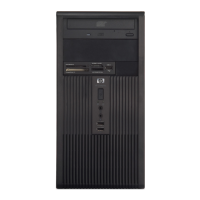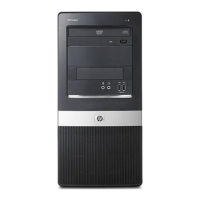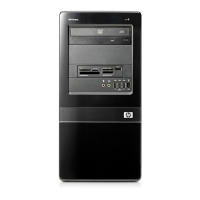Recovery software installed and configured with a recovery partition on the boot hard drive.
Pressing F11 causes the system to boot to the recovery partition and launch HP Backup and
Recovery. The F11 = Recovery prompt can be hidden with the F11 prompt (hidden/displayed)
option (see above).
●
Option ROM prompt (enable/disable) Enabling this feature will cause the system to display a
message before loading option ROMs. (This feature is supported on some models only.)
●
Remote wakeup boot source (remote server/local hard drive).
●
After Power Loss (off/on/previous state): Setting this option to:
●
Off—causes the computer to remain powered off when power is restored.
●
On—causes the computer to power on automatically as soon as power is restored.
●
On—allows you to power on the computer using a power strip switch, if the computer is
connected to an electric power strip.
●
Previous state—causes the computer to power on automatically as soon as power is
restored, if it was on when power was lost.
NOTE: If you turn off power to the computer using the switch on a power strip, you will not
be able to use the suspend/sleep feature or the Remote Management features.
●
POST Delay (None, 5, 10 15, or 20 seconds). Enabling this feature will add a user-specified
delay to the POST process. This delay is sometimes needed for hard disks on some PCI cards
that spin up very slowly, so slowly that they are not ready to boot by the time POST is finished.
The POST delay also gives you more time to select F10 to enter Computer (F10) Setup.
●
I/O APIC Mode (enable/disable). Enabling this feature will allow Microsoft Windows Operating
Systems to run optimally. This feature must be disabled for certain non-Microsoft Operating
Systems to work properly.
●
Hyper-threading (enable/disable)
●
Limit CPUID Maximum Value to 3. Restricts the number of CPUID functions reported by the
microprocessor. Enable this feature if booting to Windows NT.
Execute Memory Test
(some models)
Restarts the computer and executes the POST memory test.
BIOS Power-On Allows you to set the computer to turn on automatically at a time you specify.
Onboard Devices Allows you to set resources for or disable onboard system devices (diskette controller, serial port,
or parallel port).
PCI Devices
●
Lists currently installed PCI devices and their IRQ settings.
●
Allows you to reconfigure IRQ settings for these devices or to disable them entirely. These
settings have no effect under an ACPI-based operating system.
PCI VGA Configuration Displayed only if there are one or more PCI graphics controllers in the system and the integrated
video is enabled. Allows you to specify which VGA controller will be the “boot” or primary VGA
controller.
Table 6 Computer Setup—Advanced (for advanced users) (continued)
ENWW Computer Setup (F10) Utilities 11

